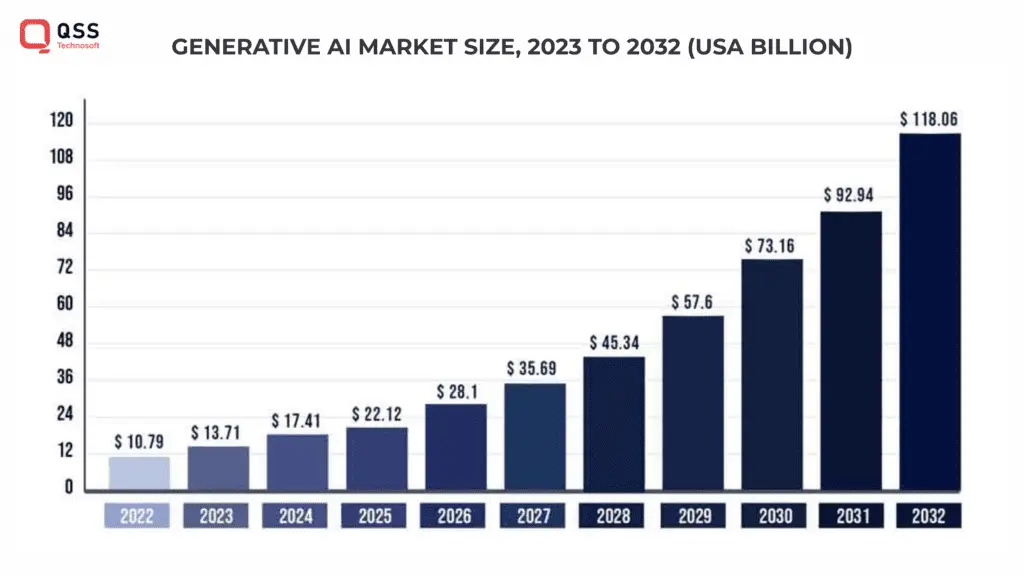Have you ever wondered how technology can augment human creativity and change the world of design and content creation? Let’s take a quick example of a tool that can generate countless unique designs, customized to your preferences, in a matter of minutes. Well, generative AI has made this a reality. Sounds shocking right? But AI has made this possible.
AI, or generative intelligence, has completely changed several industries, including design and content production. Generative AI has the power to completely alter various sectors by mimicking human inventiveness and producing unique designs. And this is not just it!
Make sure to read this blog till the end because we are going to explore the impact of generative AI in design and content creation.
What is Generative AI?
Generative AI refers to algorithms and systems that can generate new and original content, such as images, music, text, or even interactive experiences. These systems use machine learning techniques to learn from existing data and create new content based on that knowledge. Generative AI can be used in a wide range of applications, including design and content creation.
Let’s understand this with a real example
Example: “DeepArt” app developed by the company DeepDream. Users can upload their own photos and select a particular artistic style, such as the paintings of Van Gogh or the brushstrokes of Picasso.

The generative AI algorithms then analyze the style and content of the image and produce a newly generated artwork that combines the content of the original photo with the chosen style. Seems a great tool with lots of AI features.
Benefits of Generative AI in Design and Content Creation
There are indeed many pros of generative AI in design and content creation. Let’s take a look at some mentioned below.
Enhancing Creativity:Generative AI can assist designers and content creators in expanding their creative possibilities by providing them with new ideas and inspiration. QSS Technosoft can provide generative AI tools that help in generating unique design options based on input keywords or parameters. For example, a designer can input a few keywords or parameters into a generative AI tool, and it can generate dozens of different design options, each with a unique twist.
Efficiency and Time-saving:Design and content creation processes can be time-consuming. Generative AI can automate repetitive tasks and generate designs or content at a faster pace, allowing designers to focus on higher-level tasks.
For instance, a generative AI tool can automatically generate multiple variations of a logo, saving designers countless hours of work.
Self Made Touch
Generative AI can create personalized designs and content by analyzing user preferences and patterns. This can help businesses deliver tailored experiences to their customers, leading to improved engagement and satisfaction.An example of this is personalized product recommendations generated by e-commerce platforms based on user browsing and purchase history.
Exploratory Design:Generative AI can assist designers in exploring new design styles, techniques, or combinations that they may not have considered. This experimentation can lead to novel and innovative designs.For instance, a generative AI tool can generate abstract patterns or visualizations that inspire designers to explore new design directions.
Improving Accessibility:This can lower entry barriers for non-designers, enabling users without formal design training to create stunning visuals or content. This democratization of design can empower individuals or small businesses to create professional-level designs.For example, graphic design platforms like Canva use generative AI to provide pre-designed templates that users can customize with their own content.
Steps in Using Generative AI in Design and Content Creation
Step 1: Collect and Prepare Training Data
To utilize generative AI effectively, an extensive dataset is required. For instance, in music composition, the training data could consist of a large collection of songs from various genres, artists, and periods. The data must be properly labelled and prepared to facilitate the learning process.
Step 2: Training the Generative AI Model
Using the prepared dataset, a generative AI model needs to be trained. This involves feeding the model with the data and allowing it to learn patterns, styles, or themes present in the training set. This training process can take time, depending on the complexity of the desired output.
Step 3: Fine-tuning the Model
After the initial training, fine-tuning the generative AI model may be necessary to refine the output. This involves adjusting parameters, experimenting with different architectures, or incorporating user feedback to improve the generated designs or content.
Step 4: Validation and Testing
Evaluating the generative AI model’s performance is crucial. The model should be tested against various test datasets or real-world scenarios to ensure the quality and accuracy of the output. User feedback can also be valuable in identifying areas for improvement.
Step 5: Implementation and Integration
Once the generative AI model is validated, it can be implemented into the design or content creation workflow. Integration with existing design tools or software may be necessary to streamline the process and make it more accessible to designers and content creators.
Market Overview/Latest Statistics
Generative Artificial Intelligence (AI) has experienced a significant rise in popularity in recent years. With its ability to create original content such as images, music, and text, Generative AI has found applications in various industries including entertainment, marketing, and e-commerce.
According to a report published by MarketsandMarkets, the Generative AI market is projected to reach $4.1 billion by 2023, growing at a compound annual growth rate (CAGR) of 20.9% during the forecast period. This indicates a substantial market opportunity and increasing demand for generative AI technology.
Another research study by OpenAI, titled “Generative Models,” highlights the impact of generative AI in various domains. The research shows that generative AI models have achieved state-of-the-art performance in tasks such as image synthesis, text generation, and music composition.

Challenges You Might Have To Face:
While generative AI offers immense benefits, it also presents certain challenges and ethical considerations. At QSS Technosoft, we take these concerns seriously and strive to address them responsibly:
Intellectual Property and Copyright
Generative AI raises questions about intellectual property and ownership of the generated designs or content. The source of inspiration, underlying datasets, or algorithms used in training the model can complicate the legal and ethical implications.
For example, who owns the rights to a logo generated by a generative AI tool?
We understand the legal and ethical implications surrounding intellectual property and copyright when it comes to generative AI. We work closely with our clients to ensure transparency and provide clarity regarding ownership rights and the source of inspiration.
Bias and Fairness
These models learn from existing data, which may contain biases. These biases can perpetuate stereotypes or discrimination in the generated designs or content. Ensuring fairness and addressing biases in the generative AI system is crucial.
For instance, a generative AI system trained solely on data from a specific demographic might create biased representations.
QSS Technosoft is committed to creating generative AI models that are unbiased and fair. We take steps to mitigate biases in the training data and continually monitor and evaluate the output to ensure fairness in the generated designs or content.
Human and AI Collaboration
Generative AI should not replace human designers but rather augment their creative capabilities. Finding the right balance between human creativity and generative AI assistance is important to preserve the artistic and creative essence of design and content creation.
An example of effective collaboration is when a designer uses generative AI tools to generate initial design concepts and then adds their personal touch and refinement.
We believe in the importance of maintaining the artistic and creative essence of design and content creation. Our generative AI solutions are designed to augment human creativity, encouraging collaboration between designers and the AI tools we develop.
Technical Limitations
Generative AI models may face limitations in generating complex and high-resolution designs or content. Overcoming these technical challenges requires advancements in hardware, algorithms, and datasets.
For example, generating highly-detailed 3D models in real-time is still a challenging task for generative AI.
QSS Technosoft acknowledges the technical limitations that generative AI models may face, such as generating complex or high-resolution designs. We stay at the forefront of advancements in hardware, algorithms, and datasets to overcome these challenges and deliver the best possible results.
Conclusion
Generative AI has the power to revolutionize design and content creation, enhancing creativity, saving time, enabling personalization, and improving accessibility. With QSS Technosoft’s expertise in generative AI, you can take advantage of this technology while addressing challenges and ethical considerations responsibly. Contact us at QSS Technosoft to learn more about how we can help you use generative AI in your design and content creation processes.
We are proud to mention that our work has been recognized by leading B2B reviews and research platforms like GoodFirms, Clutch, MirrorView, and many more.

Exploring the Impact of Generative AI in Design and Content Creation